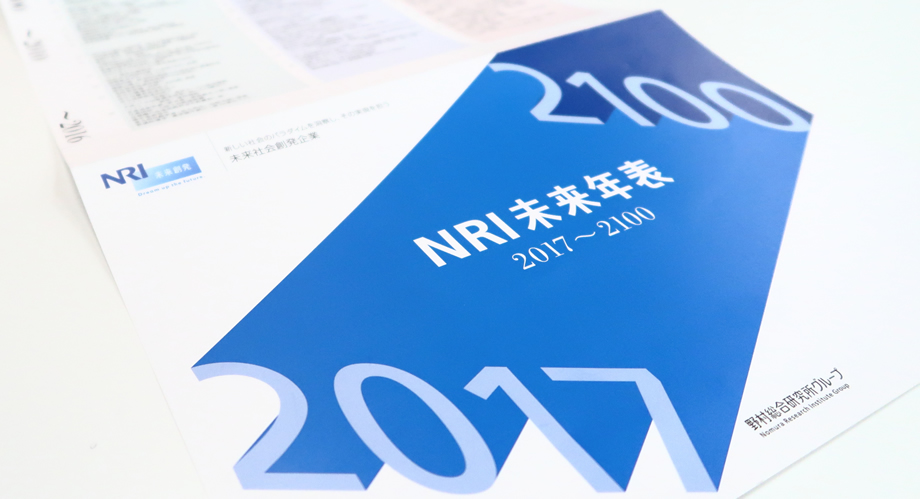
“NRI’s Future Timeline”: Predicting the Future Up To 2100
Each year, Nomura Research Institute, Ltd. (“NRI”) prepares its “NRI Future Timeline”, which classifies various events that are scheduled or predicted to occur in terms of “Politics and Society”, “Economics and Industry”, and “International” categories and sets forth NRI’s projections for the future. At the end of last year, the company released its latest version, “NRI Future Timeline: 2017-2100”, which forecasts the prospects up to the year 2100. We provide an overview of this newest release here.
Rise in longevity the main factor behind the ongoing growth of the global population
The basis for future projections is the population projections. This is because demographic trends have a major impact on social systems and economic structures. For this current timeline, we relied on the latest population projections done by domestic and foreign institutions to determine the prospects until the year 2100.
According to U.N. statistics, the global population which stood at roughly 7.3 billion persons as of 2015 will reach 10 billion in 2056, and is set to hit 10.3 billion in 2065, before climbing to 11.2 billion in the year 2100.
Global population growth was once attributed to population explosions in developing countries in regions such as Asia and Africa—in other words, to rising birth rates in those areas. However, nowadays the main factor is increasing longevity. The global population of persons 65 years and older is set to reach 1.6 billion in 2050 (2.6 times the 2015 level), 1.9 billion in 2065 (3.2 times), and 2.5 billion in 2100 (4.2 times), meaning the percentage of elderly persons will be growing rapidly.
Japan’s declining population is leading the housing market to shrink
With the world’s fastest declining birthrate and most rapidly aging populace, Japan will continue to see its population numbers fall. Projections by the National Institute of Population and Social Security Research (IPSS) tell us that Japan’s total population, which in 2015 stood at 127.1 million, will drop down to 120.7 million in 2025, fall below the 100 million mark to just 97.1 million in 2050, go down to 86.7 million in 2060, and finally fall to approximately 83 million in the year 2100, which amounts to roughly two-thirds of its current level. In 2015 the country ranked eleventh in the world in total population, yet it will have fallen to 30th place in the year 2100, and will no longer be thought of as a highly populous country.
No area will feel the effects of this population shrinkage more deeply than the housing market. NRI continually conducts forecasts of Japan’s housing market, and estimates that the number of new housing starts—which stood at approximately 920,000 in FY2015—will contract to about 670,000 in FY2025, and drop down to only about 540,000 in FY2030.
Use of AI and robots underway in developed countries
As the aging of the population is progressing on a global scale, with this phenomenon being most conspicuous in developed countries, the real concern is labor shortages. Deficiencies in the labor force have direct links to economic activity.
According to the Cabinet Office, it is projected that by the year 2030 Japan’s work force will lose approximately 9 million workers compared to 2013 figures, dropping to 56.8 million. Meanwhile, the outlook from The Ministry of Economy, Trade and Industry (METI) suggests that around the same year we will see such gains in efficiency and automation from artificial intelligence (AI) and robot technology that the job market will shed 7.35 million workers, but this estimate envisions a future in which the contraction of the labor force will be substituted for by AI and robots.
A joint study conducted by NRI and Oxford University Associate Professor Michael Osbourne et al. estimated that in the period from around 2025 to 2035, roughly 49% of Japan’s labor force could be replaced by AI and robots.
Further, a different NRI forecast indicated that in 2050, the market scales for self-driving vehicles using AI and nursing care robots will be enormous, respectively amounting to roughly 4.6 trillion yen and 277 billion yen.
U.S. futurist Ray Kurzweil predicts that in the year 2045, AI capabilities will surpass the sum of all human intelligence. It may be inferred that efforts are underway to effectively leverage such AI capabilities in order to compensate for the labor shortages expected to befall developed countries, and to maintain and improve productivity.
Click to view NRI’s Future Timeline: 2017-2100 (Japanese only)